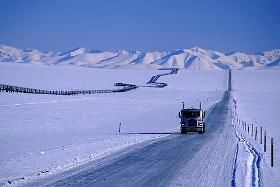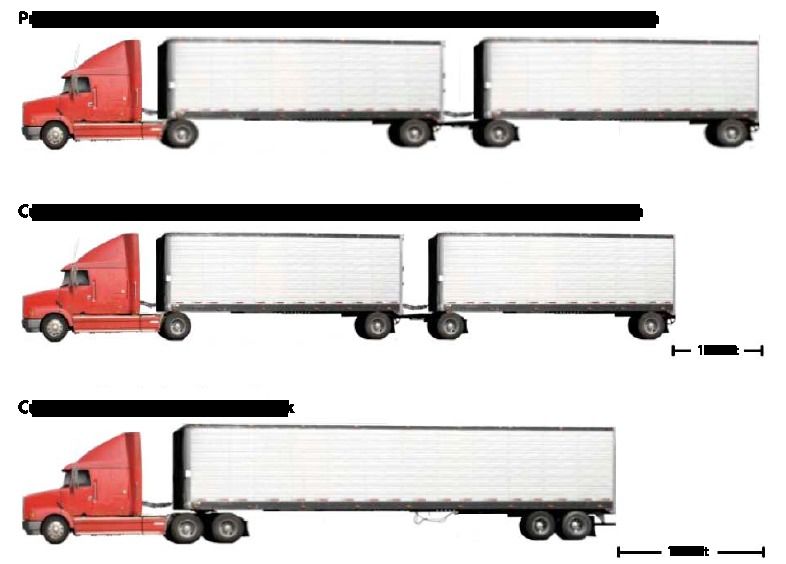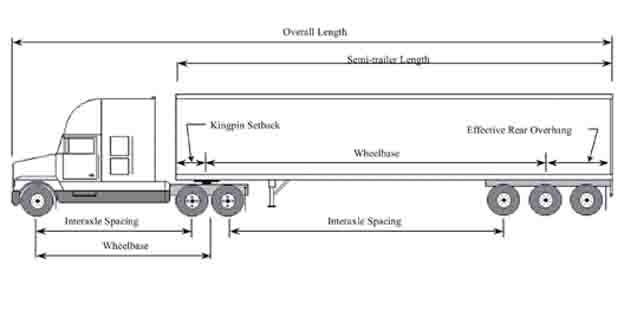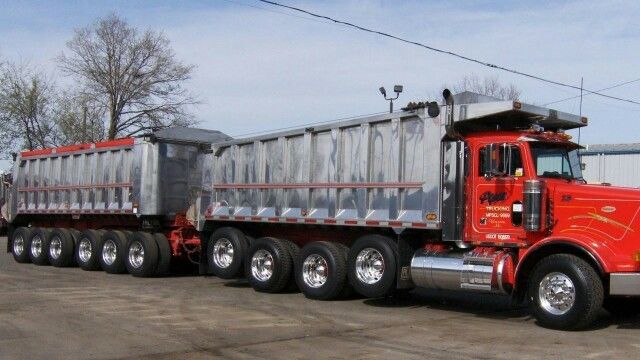How About Them Double 33's?
Topic 10169 | Page 1
The industry has always pushed for longer, heavier trucks. In New York you've already been able to pull 48' doubles on the Thruway (I-90) across the state for years.
Did they specifically mention increasing the weight also?
Doubles:
Refers to pulling two trailers at the same time, otherwise known as "pups" or "pup trailers" because they're only about 28 feet long. However there are some states that allow doubles that are each 48 feet in length.

Like Brett said, they've been discussing this for a while in the industry. With increased capacity, I can only imagine that they'd need to push for higher GVCW ratings. The problem with this is, I can't imagine a LW truck would be able to manage much more than the industry standard of 80,000 lb. as is. Bloomberg just ran an article regarding the topic not long ago, although its a little bare-boned in my opinion.

I don't see how it would FORCE people out of 53' rigs. Heck, Swift ALREADY knows about Rocky Mountain Doubles (48' followed by a 28' trailer). What it will do is allow Fed Ex and the like to haul more freight. However, NON-LTL companies will do just fine, as shippers will still want to load as much freight in ONE trailer as possible.
Shipper:
The customer who is shipping the freight. This is where the driver will pick up a load and then deliver it to the receiver or consignee.
LTL:
Less Than Truckload
Refers to carriers that make a lot of smaller pickups and deliveries for multiple customers as opposed to hauling one big load of freight for one customer. This type of hauling is normally done by companies with terminals scattered throughout the country where freight is sorted before being moved on to its destination.
LTL carriers include:
- FedEx Freight
- Con-way
- YRC Freight
- UPS
- Old Dominion
- Estes
- Yellow-Roadway
- ABF Freight
- R+L Carrier
Doubles:
Refers to pulling two trailers at the same time, otherwise known as "pups" or "pup trailers" because they're only about 28 feet long. However there are some states that allow doubles that are each 48 feet in length.

In addition to 26' combination vehicles, you can see B-trains and these LCVs on the highways of British Columbia, Alberta, Saskatchewan, Manitoba, Ontario, Quebec, New Brunswick, and Nova Scotia. The operators need special permitting and the drivers need exemplary records and extra training to operate. Oh, Canada has a higher weight limit for CMV as do many US states, so big trucks aren't that uncommon.
Combination Vehicle:
A vehicle with two separate parts - the power unit (tractor) and the trailer. Tractor-trailers are considered combination vehicles.
CMV:
Commercial Motor Vehicle
A CMV is a vehicle that is used as part of a business, is involved in interstate commerce, and may fit any of these descriptions:
- Weighs 10,001 pounds or more
- Has a gross vehicle weight rating or gross combination weight rating of 10,001 pounds or more
- Is designed or used to transport 16 or more passengers (including the driver) not for compensation
- Is designed or used to transport 9 or more passengers (including the driver) for compensation
- Is transporting hazardous materials in a quantity requiring placards
I located a PDF copy of the main report: MAP-21 Comprehensive Truck Size and Weight Limits Study by the Federal Highway Administration. (By the way, there's another group, Coalition for Transportation Productivity, that likes the idea of 53' trailers with three axle tandems ("Triandems"?) They propose a weight limit if 91,000 in 53 feet.)

@Brett: I think it's not set yet, but the weight may go up to 91k or even 97k per combination.
@Armyman: It's a function of economics. The report studied many different combinations that the Trucking industry would move to for competition and economic reasons. The biggest move, according to the MAP-21 report would be to the 3-axle 53' with 91,000 pound weight limit. The second would be the 33' doubles , either 91k or 97k limit.
Tandems:
Tandem Axles
A set of axles spaced close together, legally defined as more than 40 and less than 96 inches apart by the USDOT. Drivers tend to refer to the tandem axles on their trailer as just "tandems". You might hear a driver say, "I'm 400 pounds overweight on my tandems", referring to his trailer tandems, not his tractor tandems. Tractor tandems are generally just referred to as "drives" which is short for "drive axles".
Tandem:
Tandem Axles
A set of axles spaced close together, legally defined as more than 40 and less than 96 inches apart by the USDOT. Drivers tend to refer to the tandem axles on their trailer as just "tandems". You might hear a driver say, "I'm 400 pounds overweight on my tandems", referring to his trailer tandems, not his tractor tandems. Tractor tandems are generally just referred to as "drives" which is short for "drive axles".
DOT:
Department Of Transportation
A department of the federal executive branch responsible for the national highways and for railroad and airline safety. It also manages Amtrak, the national railroad system, and the Coast Guard.
State and Federal DOT Officers are responsible for commercial vehicle enforcement. "The truck police" you could call them.
Doubles:
Refers to pulling two trailers at the same time, otherwise known as "pups" or "pup trailers" because they're only about 28 feet long. However there are some states that allow doubles that are each 48 feet in length.
Dm:
Dispatcher, Fleet Manager, Driver Manager
The primary person a driver communicates with at his/her company. A dispatcher can play many roles, depending on the company's structure. Dispatchers may assign freight, file requests for home time, relay messages between the driver and management, inform customer service of any delays, change appointment times, and report information to the load planners.
I see the double 53' configuration frequently, and those 53' tridem trailers every day. I'll try and keep note when I drive near one and post a dash cam video of there's interest. I suspect most folks have seen these setups before, but you never know.
HOS:
Hours Of Service
HOS refers to the logbook hours of service regulations.Michael, The illustrations I used came from Canadian pages! The larger combinations are more common in Canada. Remember the issue is about two 53' trailers together - a Canadian Turnpike Double. We don't get those south of the Border.
Then there's Michigan trucks:
HOS:
Hours Of Service
HOS refers to the logbook hours of service regulations.Michael, The illustrations I used came from Canadian pages! The larger combinations are more common in Canada. Remember the issue is about two 53' trailers together - a Canadian Turnpike Double. We don't get those south of the Border.
Then there's Michigan trucks:
Those Michigan trucks always weirded me out. I called em centipedes.
You see three and four axle trailers all over the place in Washington, Oregon, and Idaho. Central Oregon Trucking has a crapload of four axle flatbed trailers, Tate and Doug Andrus use a lot of three axle trailers, Haney, Gordon, and Interstate all do a lot of heavy-haul with four axle trucks and trailers, and just about every wood chip trailer in the region has four axles. Just some examples off the top of my head.
Interstate:
Commercial trade, business, movement of goods or money, or transportation from one state to another, regulated by the Federal Department Of Transportation (DOT).
HOS:
Hours Of Service
HOS refers to the logbook hours of service regulations.New Reply:
New! Check out our help videos for a better understanding of our forum features

















Preview:








 TT On Facebook
TT On Facebook
Got an email today from none other than the founder of Swift, Jerry Moyes. I suppose every other driver got the same one, though.
I hadn't heard about this before, but evidently LTL carriers are pushing for double trailers 33 feet long each. (Right now, double pups are 28' each) Jerry claims the whole rig: tractor + 2 x 33' will be 91 feet of rolling freight & metal. (more weight?)
Yes, write your congressman and all that. A helpful link if you are so inclined: Say NO to 33'
Swift claims "Experience shows that longer double-trailers will force us out of 53s and into double 33s — an over-the-road sleeper rig that is 91-feet long, the equivalent of an eight-story building on wheels. And us 53' drivers will need training for the longer combinations.
Here's a link to the Coalition Against Bigger Trucks: www.cabt.org
LTL:
Less Than Truckload
Refers to carriers that make a lot of smaller pickups and deliveries for multiple customers as opposed to hauling one big load of freight for one customer. This type of hauling is normally done by companies with terminals scattered throughout the country where freight is sorted before being moved on to its destination.
LTL carriers include: